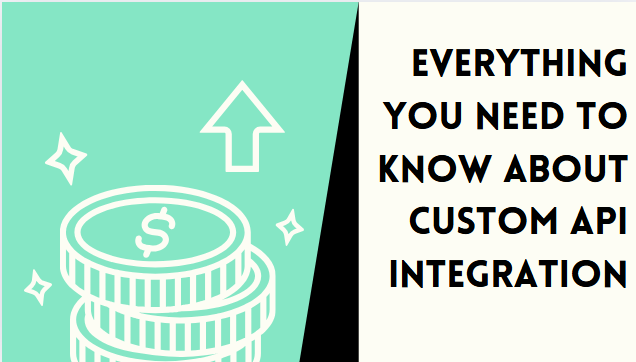All modern software development highly utilize the use of APIs as they help various software applications to interact. Custom API development and integration provide a lot of value to businesses in terms of efficiency, Customer Experience, and revenues.
In this guide, readers will learn the basic features of any API, the benefits of developing a custom API, and key indicators of success.
What are APIs?
API, abbreviated from Application Programming Interface, refers to a specified system that serves as an interface between applications. They act as intermediaries, or a physical hub for data swapping between various systems or applications. APIs are critical when it comes to web creation, smartphone applications, and even cloud computing.
APIs operate under principles that lay down how two applications can interface and integrate. They represent a fixed way from which a programmer can request data, service, or some functionality from another application without having to gain permission to the code. This makes it easy for developers to have large, evolvable, and composable applications.
Best Practices for Custom API Development
Techniques for creating new custom APIs are therefore useful and should be properly planned and implemented so that they provide security and user friendly while being scalable. Below are key best practices for custom API development:
Define a Clear Business Case
The first thing any developer should realize about the API they will work on is the API’s intended use. Knew what the business case required, the goal, the requirement to complete the API, and the risk, and challenge associated with the API.
Use a RESTful API Architecture
REST otherwise known as Representational State Transfer is one of the most popular and scalable options for web APIs. RESTful APIs are simple, and extensible and make use of HTTP methods GET, POST, PUT, and DELETE when interacting with resources.
Design for Scalability
Do not let the capacity to handle increased traffic and usage increase degrade the API by making it stateless. The use of one request to build another request should be eliminated to enhance the scalability of the system.
Implement Robust Security Measures
It can be a security threat for applications, thus, security should be maintained at its highest level. To protect API several methods may be employed including API keys, OAuth 2.0 authentication, use of SSL encryption, and rate limiting.
Provide Comprehensive Documentation
Documentation should be clear and detailed to avoid confusing or misleading readers by making the code easier to use and modify. Define the endpoint and the parameters that are taken or provided by the API, the responses that are provided by the API, and API calls with examples and lessons for developers.
Test Rigorously
Testing should be done effectively especially in the development of API to check on every error that may occur to the users. Testing of APIs should not only cover functional tests but also contain another non-functional tests like performance, reliability, and security tests to check their capability in different functional test cases.
Monitor and Analyze Usage
This would mean that constant overseeing and evaluation of APIs is crucial in the quest to realize the best results and the satisfaction of the users. The available analytics tools can provide insights on usage patterns, error rates, and other factors that can point a business to the need to adjust their APIs, alongside improving the general usage experience.
What Does It Take to Build an API?
Custom API development and maintenance require the following key elements:
Strategy, Expertise & Skill
Building a proper and efficient API requires qualified and well-experienced programmers in languages, frameworks, and security. A special person asks a technical specialist to implement a particular goal and is in charge of the process. Overhead, ‘development’, ‘strategy,’ and ‘project management’ are expensive and lengthy.
Infrastructure and Tools
API development needs to have and sustain some other supportive structure like servers, databases, and security. Development tools include expenses such as licensing or subscription fees for the tools and frameworks used in development.
Testing and Quality Assurance
Testing is a critically important process since it implies verification of API functionality, testing of the API with different conditions, and checking for security vulnerabilities. Sophistication is important to ensure the quality of the product since clients are assured of a stable product.
Documentation and Support
Documentation is clear and informative and it is an essential requirement for API users to follow when integrating and using the APIs. It also requires constant assistance to fix the problems; troubleshoot different aspects and make the system functional.
Security and Compliance
API is filled with user information or data, which means that it has to be protected from being violated and accessed by unauthorized personnel. Nonetheless, other activities require constant practice; for example, encryption, authentication, and compliance regulations.
Maintenance and Updates
The API may need to be updated frequently depending on the emergence of new incompatible technologies or handling of bugs, performance optimization, and security issues as well as compatibility with other third-party APIs.
Key Applications of Custom API Integration in Business
Before we proceed further let’s look at some of the areas that would explain how custom API integration would prove to be useful to a business.
The uses of custom API integration in business.
Streamlined E-commerce Operations
Professionality is vital in the e-commerce business. API integration is done with any specific undertakings, coordinate inventory management and order in addition to shipping solutions to avoid distortion of inventory and improve on order completion times. It also helps in reducing over-selling incidences as well as improving on satisfaction of the clients through proper delivery.
Unified Customer Relationship Management (CRM)
The use of custom APIs to the other platforms that are in the organization’s use centralizes customer information where the various departments such as the sales, marketing as well as support departments can access real-time information from the various clients who have been engaged. This consolidated strategy also allows for more homogenized client servicing.
Enhanced Financial Management
Custom API connectors refer to the integration of accounting solutions with checkouts, enterprise resource planning, and banking. This enhances the efficiency of cash flows and expedites reconciliation besides offering real-time Information.
Human Resources Automation
Businesses’ HR departments work with a lot of data, such as data on the company’s employees and payroll. Integrating HR systems; through APIs increases the efficiency and accuracy of records through the automation and accuracy of linked systems.
Conclusion
Of all the benefits of both custom API development and API integration, the business benefits are as follows; Increased business productivity, better customer satisfaction, increased sales, and overall business competitiveness. They enable real-time exchange of information, manage organizational processes, automate functions, and enhance efficiency simultaneously eliminating pervasive lapses. While often overlooked, utilizing software integration can help organizations tailor offerings to customers, improve the flow of operations, and extract insights about consumers.
For organizations to realize these advantages, much attention should be paid to API design and deployment including; security, scalability, flexibility API documentation, testing, and API monitoring. It is quite evident that when proper planning and optimization are employed, then firms can design and develop their unique set of APIs that can fuel their growth for the existence of their business.

